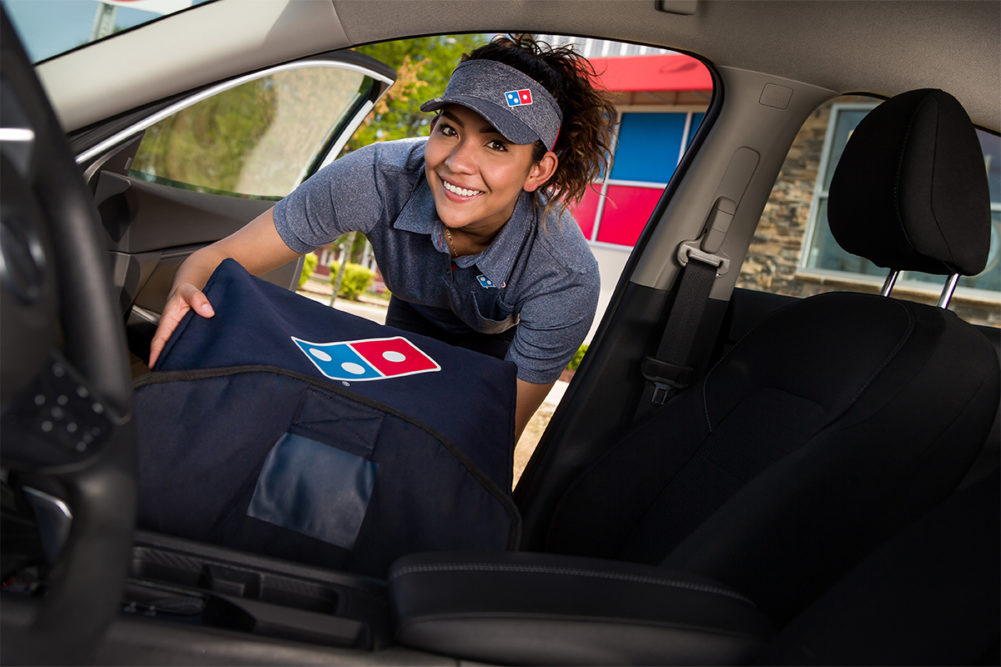ANN ARBOR, MICH. — Domino’s Pizza, Inc. has a delivery problem: not enough delivery drivers.
“When we look across the US business, we continue to believe that consumer demand for Domino’s remains very strong across the country,” said Richard E. Allison, chief executive officer, in an April 28 earnings call to discuss first-quarter financial results. “It is our current capacity to serve that strong demand, particularly for delivery customers, that has continued to be our greatest near-term challenge.”
US same-store sales declined 3.6% in the quarter ended March 27. US carryout same-store sales rose 11%, but US delivery same-store sales dropped 11%.
“The decline in US same-store sales in Q1 was driven by a decline in order counts, which were pressured by the very challenging staffing environment, which had certain operational impacts, such as shortened store hours and customer service challenges in many stores, both company-owned and franchised,” said Sandeep Reddy, chief financial officer. “The decline in order counts was partially offset by ticket growth, resulting from higher menu prices as well as more items per transaction and increases to our average delivery fee.”
Ann Arbor-based Domino’s breaks down its US stores into quintiles based on staffing levels relative to a fully staffed store, Mr. Allison said.
“When we look at the same quintiles relative to the delivery business, we see the stark impact that staffing had during the first quarter,” he said. “We saw a 17-percentage-point gap in delivery same-store sales between stores in the top 20% and those in the bottom 20%. It is this disparity in delivery performance that is driving the overall contrast in performance across our US business. The gap between our top performers and our bottom performers has widened over the past year, and we are keenly focused on lifting up the underperforming stores.”
Domino’s is not only raising wages for delivery drivers but also pointing out how the position could lead to a management role, Mr. Allison said. A TV commercial shows a woman who began as a driver and now is an owner for Domino’s.
“If you want to be a general manager at Domino’s and an owner at Domino’s, it all starts as being a driver,” Mr. Allison said.
International same-store sales, excluding the impact of foreign currency, rose 1.2% in the quarter.
“India once again led our international markets in store growth and opened (its) 1,500th store during the quarter,” Mr. Allison said. “This was accompanied by a continued same-store sales growth. We also continue to see strong sales and store growth from China.”
Companywide in the quarter Domino’s had net income of $91 million, or $2.50 per share on the common stock, which was down 23% from $118 million, or $3 per share, in the previous year’s first quarter. Lower income from operations of $22 million resulted from lower US company-owned stores and supply chain operating margins and higher general and administrative expenses. Revenues increased 2.8% to $1.01 billion from $984 million. Domino’s stock price on the New York Stock Exchange closed at $353.88 per share on April 28, which was down 5% from $372.91 per share at the close of April 27.
“We got off to a slow start in January due to the omicron surge, which impacted our stores and supply chain centers, further limiting our capacity to serve customer demand, particularly in the delivery channel,” Mr. Allison said. “After a return to modestly positive US same-store sales in February, we turned negative again as we began to overlap the impact of the 2021 federal government stimulus in March and have continued to face that overlap in April.”
He added, “We have action plans in place that are designed to address the issues in our US business as well as other initiatives that we are developing, but that work will take some time, and we believe that we will continue to face pressure, both on the top line for our US business and on our bottom-line earnings, over the next few quarters. While we remain very optimistic about our ability to drive long-term profitable growth, in the near term, 2022 is shaping up to be a challenging year.”
The company is working on several initiatives to improve profitability, Mr. Reddy said.
“These include, No. 1, exploring further optimization of our consumer pricing architecture in the United States,” he said. “Specifically, this covers our many levers of pricing, which includes our standard menu pricing, national offers, local offers and delivery fees, to enable both our company-owned and franchisee stores to better cover the cost increases we are facing in both the food basket and labor market.
“No. 2, efficiencies in our cost structure as we seek to ensure that revenues consistently grow faster than expenses. No. 3, actions to accelerate our capacity to service the demand we see and generate incremental sales growth. Once implemented, we expect the initiatives I just covered to enable annual operating income margins to recover to pre-pandemic levels post 2022.”




